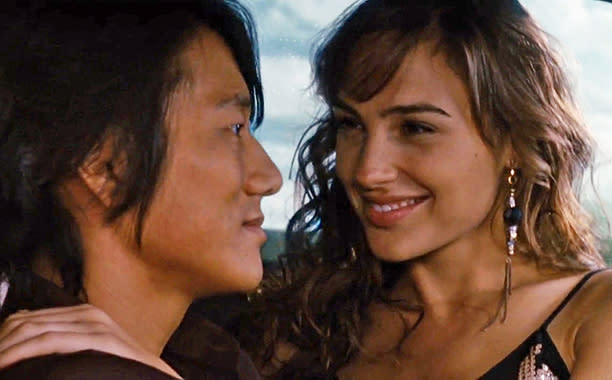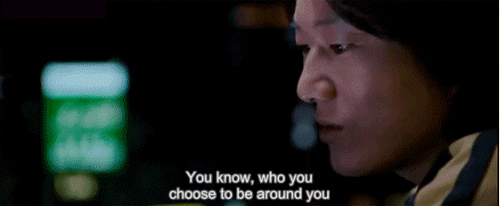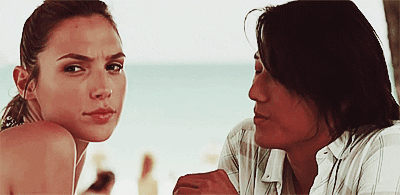Fast & Furious: Tokyo Drift: Here's the story of Han
In the Fast & Furious franchise’s diverse and boisterous ensemble, Han Seoul-Oh and his subtlety stand out. The character’s trademark skill is to be as slick and unnoticeable as possible. He’s effortlessly cool. His first foray into the series was as the silent, snacking mentor to Sean Boswell (Lucas Black) in Tokyo Drift, which turns 10 on Thursday. Despite Han’s death in the 2006 film, the Furious universe twisted its chronology to include Han in the three following movies, a principal character in two of them.
That wasn’t the first time Sung Kang stepped into Han’s shoes — or a Justin Lin movie, for that matter. The 44-year-old actor debuted the character, then a hardened teen fond of beating up his little cousin and puffing cigarettes, in Lin’s 2002 breakout movie Better Luck Tomorrow.
In a way, viewers grew up with Han — seeing him evolve from a deeply passionate and emotional kid to the collected member of Dom Toretto’s (Vin Diesel) family. To celebrate the 10th anniversary of Tokyo Drift and the arrival of Han in the franchise, Kang and Lin look back on the character and dig into Han’s origin story.

Better Luck Tomorrow
Lin’s 2002 indie was loosely inspired by the 1992 Honor Roll Murder, where five high school students killed 17-year-old Stuart Tay, as they believed the student was trying to betray them in a future heist. In the movie, four disaffected Orange County teens band together to form a cheat sheet racket, earning extra cash and filling non-studying time with meaning. Ben (Parry Shen) is Ivy-bound and looking for more from life beyond school; Virgil (Jason Tobin) fills in as the hedonistic wildcard/best friend; and Daric (Roger Fan) is the valedictorian-in-waiting ringleader.
Virgil’s cousin, Han, rounded out the group as the de facto enforcer. Originally, he was supposed to be harder —”almost a stereotype of everything that is bad of Asian gangsters, a wannabe thug,” Kang describes. “I said, ‘I’m not sure if I’m into that.'”
Both broke at the time, Kang and Lin met at Denny’s to talk about the movie. Kang felt Han was “sparse” and asked to read for Ben. It was a small test for Lin, as Kang didn’t feel right for the lead. Sure enough, Lin didn’t see Kang as Ben, but really wanted him as Han — so much so Lin sought to “absorb as much Sung Kang as possible” to craft Han.
Kang developed a backstory that pitted him as more than the gangster-type. He saw Han as a truly American kid (“There’s no Asian-ness to him,” Kang says) with immigrant, working-class parents, including a mechanic father — hence the orange 1965 Ford Mustang. Han grasps the identity he fought to wear.
“He’s the one guy that doesn’t say a lot, but he has a presence, and he’s earned that Mustang,” Lin says. “He’s earned every cigarette he smokes. That was something that was very clear. It was very Sung-influenced, the character: I’ll own up to that for sure.”
The eldest of the group, Han parties and smoothly slips into a world of petty crime, but his actions are complemented with a humanity his crew didn’t quite possess. He avoids the more dangerous vices and actions of his peers and is the most emotionally wrought in the film’s aftermath.
“He has a heaviness to him. His life isn’t easy. Even smoking, I was like, ‘Why does he smoke?'” Kang asks. “It’s not to just be cool; I don’t think Han cares about being cool. He’s fighting for something. He’s fighting for purpose.”
Kang’s first major film role was a realized, complex person. And naturally, he thought that was a one-off. “I didn’t even know what the significance of Han was. Where could that character go?” he says. Fast & Furious was a mere blip on the fringes of his and Lin’s radars.

RELATED: Fast and Furious: Brian O’Conner’s Best Moments
The Fast and the Furious: Tokyo Drift
A few years later, Kang was cleaning dishes in the restaurant he and his wife owned, since the washers didn’t show up. Lin called. It wasn’t necessarily for a role in Tokyo Drift — because there wasn’t one, Kang recalls — but to read and be seen in front a big casting director. Kang read for the lead, Sean, under no pressure. But Lin wanted to make it happen.
“When I was writing and creating the character, I had Sung in my head and I had Han in my head,” Lin says. “Very quickly, I realized, ‘Well I want Sung Kang, and I want Han.'”
After Lin showed off Han 1.0 in Better Luck Tomorrow and played Kang’s audition tape for the studio, Han 2.0 came to be.
The name’s the same, but Tokyo Drift‘s Han is richer, lonelier, calmer, and more mature. Lin imagines Han fled suburbia after the events of Better Luck Tomorrow and traveled through Thailand and Hong Kong before ending up in Japan’s capital. He serves a surrogate father to Sean and others in Tokyo, housing them in his garage. The two Hans’ worlds are completely different. “Fast & Furious Han lives in la-la land,” Kang says. “Han in Better Luck Tomorrow ate at McDonald’s, most likely. Han in Tokyo Drift could go to Nobu if he wanted to, but he chooses not to.”
He parcels out morsels of wisdom because he’s assured of what he wants. Allowing Sean to bust his fine-tuned car allowed him to learn the Arizona teen’s true character. “One car in exchange for knowing what a man’s made of?” Han tells Sean. “That’s a price I can live with.” Wealth and women filled his life, but were revealed as a veneer for his internal pain.
Han dies 75 minutes into Tokyo Drift, with little dialogue to work with. His habit of regularly reaching for munchies, an unscripted trait and replacement for cigarettes — something Universal leading characters don’t do — reinforced his memorability. “That’s something the Steve McQueens, the people I look up to, do,” Kang says. “Give me something to opposed to just standing there. It’s amazing how that translated onto screen.”
“What I think Sung brings is this complexity. He doesn’t overdo it. I feel like when he talks, those words mean something. And how he interacts, there’s something about it that was very much earned,” Lin says. “That coolness is earned. How he’s always eating or how he moves, it’s something he’s earned himself. To me, that’s what makes him intriguing to people.”
With death, Han seemed to finally be a part of Kang’s past. But Lin and the franchise didn’t make Kang return the keys just yet.

Joining the family
Franchise plot manipulation permitted Han to be in future Furious endeavors. Fast & Furious was released three years after Tokyo Drift, yet in the manicured timeline, the events of the film occur in the pre-Tokyo Drift days. That’s when Lin was trying to convince Diesel to make a cameo.
“We literally spent, I don’t know how many hours, by his poolside talking about the connection of [Han],” Lin remembers. “So much of what we talked about ended up in the Fast and Furious franchise. It was really cool, for the first time, a lot of those backstories came to life.”
A Han appearance in the Vin Diesel-directed short-film interlude, Los Bandoleros — and a blink-if-you-miss-it Fast & Furious turn — was just an amuse-bouche. Everything changed for Han, whom Lin envisions traveling the world after Better Luck Tomorrow and ultimately ending up in Costa Rica where h’s introduced to Dom, Letty, and the car culture. With the connection established, Han became a franchise regular. Life also swiftly changed for Kang.
“Before the Fast franchise, I’m just a regular dude trying to make a career. All of a sudden, you wake up and you’re Mickey Mouse,” he says. “That’s why I keep cutting my hair: I didn’t want to look like Han all the time. As I started getting older and the more detached I’ve become from the franchise, I realize, man, these fans, they support with their heart.”
Being called in by Dom and Brian (Paul Walker) in Fast Five instantly places Han on the level of Tej (Ludacris) and Roman (Tyrese Gibson). The new status ushered in an integral part of his character: the kindling romance between Han and former Mossad agent Gisele (Gal Gadot).
She sees through Han, pegging his oral fixation as a link to his life as a former smoker. They end up together after Fast Five and are seen in Hong Kong living on the run in Furious 6 and on the edge of settling down. “What Giselle represented was a partner in crime, someone that saw through everything, and there’s this deep connection,” Kang asserts. “When you lose somebody that truly makes you better, a soul mate, it affects people. Priorities change.”
Gisele sacrifices herself in Fast & Furious 6 to save Han. The effect is instant, turning the usually lax and warm driver cold. At the East Los Angeles cookout in Furious 6, closer to his Better Luck Tomorrow stomping grounds than he’s been in the series, he insists Tokyo is for him: “It’s just something I got to do,” he tells Roman. The only thing that matters is keeping Gisele’s memory alive, given the photo of her found in his wrecked car.
Han’s legacy
Furious 7 bad Deckard Shaw (Jason Statham) is revealed as Han’s murderer, inciting the action of the most recent installment. The series caught up to 2013: Barring flashbacks, another shift in the Furious lineage, or spin-offs, Han is gone. Not like Letty gone, but genuinely buried in the ground. And Kang is cool with it. “People tell me, ‘Hey man, it sucks [they] killed [you] off and you’re dead,'” he says. “That’s what makes me happy. If Han didn’t die, I don’t think he would have had the impact.”
The impact of the character affected Kang, too. The more materialistic Han from his high school days grew up and into someone grounded, with realigned priorities, a transformation mirrored by the man who played him. “In a way, Han kind of paralleled my life,” Kang says. “I used to look up to all these superficial things that now have no value. To me [now], how do I wake up with purpose? How can I use the acting stuff, how can I use the car stuff to have purpose in life? Because time is short: it could be gone just like that. Look at Paul [Walker, who was killed in 2013 in a car crash]: Who knew?”
Fast 8 shot in Cuba this spring, another foreign locale for the cast to conquer. Kang pines to go due to the old autos on the island. The travel itself showed the influence of Han on the world: Before the character, Kang would be mistaken for Jackie Chan. Now people endearingly yell “Han.”
“With pop culture, you’re able to change people’s perceptions of a whole ethnic group,” he says. “They look at me, and go, ‘Dude, if you’re like this, other Asians must be cool and be able to chill and be part of the family.'”



